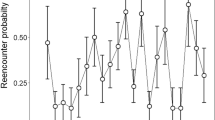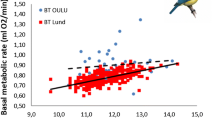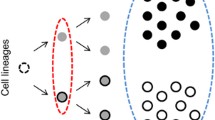Abstract
Both mass (as a measure of body reserves) during breeding and adult survival should reflect variation in food availability. Those species that are adapted to less seasonally variable foraging niches and so where competition dominates during breeding, will tend to have a higher mass increase via an interrupted foraging response, because their foraging demands increase and so become more unpredictable. They will then produce few offspring per breeding attempt, but trade this off with higher adult survival. In contrast, those species that occupy a more seasonal niche will not gain mass because foraging remains predictable, as resources become superabundant during breeding. They can also produce more offspring per breeding attempt, but with a trade-off with reduced adult survival. We tested whether the then predicted positive correlation between levels of mass gained during seasonal breeding and adult survival was present across 40 species of tropical bird measured over a 10-year period in a West African savannah. We showed that species with a greater seasonal mass increase had higher adult survival, controlling for annual mass variation (i.e. annual variation in absolute food availability) and variation in the timing of peak mass (i.e. annual predictability of food availability), clutch size, body size, migratory status and phylogeny. Our results support the hypothesis that the degree of seasonal mass variation in birds is probably an indication of life history adaptation: across tropical bird species it may therefore be possible to use mass gain during breeding as an index of adult survival.


Similar content being viewed by others
References
Allcorn RI et al (2012) Demography and breeding ecology of the critically endangered Montserrat oriole. Condor 114:227–235
Bennett PM, Owens IPF (2002) Evolutionary ecology of birds: life histories, mating systems and extinction. Oxford University Press, Oxford
Boyce MS (1984) Restitution of r- and K-selection as a model of density-dependent natural selection. Annu Rev Ecol Syst 15:427–447
Brandt MJ (2007) Trade-offs between the risks of predation and starvation in subtropical granivorous finches. Ph.D. thesis, School of Biology, St Andrews
Burnham KP, Anderson DR (2002) Model selection and multi-model inference: a practical information-theoretic approach, 2nd edn. Springer, New York
Cox DTC, Brandt MJ, McGregor R, Ottosson U, Stevens MC, Cresswell W (2011) Patterns of seasonal and yearly mass variation in West African tropical savannah birds. Ibis 153:672–683
Cox DTC, Brandt M, McGregor RM, Ottosson U, Stevens M, Cresswell W (2013) The seasonality of breeding in savannah birds of West Africa assessed from brood patch and juvenile occurrence. J Ornithol 154:671–683
Cresswell W, Clark JA, Macleod R (2009) How climate change might influence the starvation–predation risk trade-off response. Proc R Soc B Biol Sci 276:3553–3560
Crowley G, Garnett S (1999) Seeds of the annual grasses Schizachyrium spp. as a food resource for tropical granivorous birds. Aust J Ecol 24:208–220
Dingle H, Khamala CPM (1972) Seasonal-changes in insect abundance and biomass in an East African grassland with reference to breeding and migration in birds. Ardea 60:216–221
Fogden MPL (1972) The seasonality and population dynamics of equatorial birds in Sarawak. Ibis 114:307–343
Fogden MPL, Fogden PM (1979) The role of fat and protein reserves in the annual cycle of the grey-backed Camaroptera in Uganda (Aves: Syhidae). J Zool 189:233–258
Fry CH, Keith S, Urban EK (eds) (1992–2004) The birds of Africa, vols 3–7. Academic Press, London
Ghalambor CK, Martin TE (2001) Fecundity-survival trade-offs and parental risk-taking in birds. Science 292:494–497
Gibbs HL, Grant PR (1987) Adult survivorship in Darwin’s ground finch (Geospiza) populations in a variable environment. J Anim Ecol 56:797–813
Gill SA, Haggerty TM (2012) A comparison of life-history and parental care in temperate and tropical wrens. J Avian Biol 43:461–471
Gosler AG (1996) Environmental and social determinants of winter fat storage in the great tit Parus major. J Anim Ecol 65:1–17
Grant PR, Grant BR, Keller LF, Petren K (2000) Effects of El Niño events on Darwin’s finch productivity. Ecology 81:2442–2457
Griebeler EM, Caprano T, Boehning-Gaese K (2010) Evolution of avian clutch size along latitudinal gradients: do seasonality, nest predation or breeding season length matter? J Evol Biol 23:888–901
Haftorn S (1989) Seasonal and diurnal body weight variations in titmice, based on analyses of individual birds. Wilson Bull 101:217–235
Hambly C, Markman S, Roxburgh L, Pinshow B (2007) Seasonal sex-specific energy expenditure in breeding and non-breeding palestine sunbirds Nectarinia osea. J Avian Biol 38:190–197
Houston AI, McNamara JM (1993) A theoretical investigation of the fat reserves and mortality levels of small birds in winter. Ornis Scand 24:205–219
Houston AI, McNamara JM, Hutchinson JMC (1993) General results concerning the trade-off between gaining energy and avoiding predation. Philos Trans Rs Soc B 341:375–397
Lebreton JD, Burnham KP, Clobert J, Anderson DR (1992) Modelling survival and testing biological hypotheses using marked animals: a unified approach with case studies. Ecol Monogr 62:67–118
Lima SL (1986) Predation risk and unpredictable feeding conditions: determinants of body-mass in birds. Ecology 67:377–385
MacLeod R, Lind J, Clark J, Cresswell W (2007) Mass regulation in response to predation risk can indicate population declines. Ecol Lett 10:945–955
MacLeod R, Clark J, Cresswell W (2008) The starvation–predation risk trade-off, body mass and population status in the common starling Sturnus vulgaris. Ibis 150:199–208
Markman S, Pinshow B, Wright J (2002) The manipulation of food resources reveals sex-specific trade-offs between parental self-feeding and offspring care. Proc R Soc B Biol Sci 269:1931–1938
Martin TE (1987) Food as a limit on breeding birds: a life history perspective. Annu Rev Ecol Syst 18:453–487
McNamara JM, Houston AI (1987) Starvation and predation as factors limiting population size. Ecology 68:1515–1519
McNamara JM, Barta Z, Wikelski M, Houston AI (2008) A theoretical investigation of the effect of latitude on avian life histories. Am Nat 172:331–345
Molokwu MN, Olsson O, Nilsson JA, Ottosson U (2008) Seasonal variation in patch use in a tropical African environment. Oikos 117:892
Molokwu MN, Nilsson JK, Ottosson U, Olsson O (2010) Effects of season, water and predation risk on patch use by birds on the African savannah. Oecologia 164:637–645
Norris K, Evans MR (2000) Ecological immunology: life history trade-offs and immune defense in birds. Behav Ecol 11:19–26
Peach WJ, Hanmer DB, Oatley TB (2001) Do Southern African songbirds live longer than their European counterparts? Oikos 93:235–249
Perfito N, Zann RA, Bentley GE, Hau M (2007) Opportunism at work: habitat predictability affects reproductive readiness in free-living zebra finches. Funct Ecol 21:291–301
Perrins C (1970) The timing of birds breeding seasons. Ibis 112:242–255
Pinheiro J, Bates D, Debroy S, Sarkar D (2011) nlme: linear and nonlinear mixed effects models. R package version 3.1–102
Poulin B, Lefebvre G, McNeil R (1992) Tropical avian phenology in relation to abundance and exploitation of food resources. Ecology 73:2295–2309
R (Development Core Team 2011) R: A language and environment for statistical computing. R Foundation for Statistical Computing, Vienna. http://www.R-project.org
Renton K, Salinas-Melgoza A (2004) Climatic variability, nest predation, and reproductive output of Lilac-crowned parrots (Amazona finschi) in tropical dry forest of western Mexico. Auk 121:1214–1225
Ricklefs RE (1980) Geographical variation in clutch size among passerine birds: Ashmole’s hypothesis. Auk 97:38–49
Roff DA (2002) Life history evolution. Sinauer, Sunderland
Rogers CM (1987) Predation risk and fasting capacity: do wintering birds maintain optimal body-mass? Ecology 68:1051–1061
Rogers CM, Heath-Coss R (2003) Effect of experimentally altered food abundance on fat reserves of wintering birds. J Anim Ecol 72:822–830
Rozman J, Runciman D, Zann RA (2003) Seasonal variation in body mass and fat of zebra finches in South-Eastern Australia. Emu 103:11–19
Saether BE (1988) Pattern of covariation between life-history traits of European birds. Nature 331:616–617
Stevens MC, Ottosson U, McGregor R, Brandt M, Cresswell W (2013) Survival rates in West African savannah birds. Ostrich 84:11–25
Sylla MB, Dell’Aquila A, Ruti PM, Giorgi F (2010) Simulation of the intra-seasonal and the interannual variability of rainfall over West Africa with RegCM3 during the monsoon period. Int J Climatol 30:1865–1883
Thiollay JM (1988) Comparative foraging success of insectivorous birds in tropical and temperate forests: ecological implications. Oikos 53:17–30
Tokolyi J, McNamara JM, Houston AI, Barta Z (2012) Timing of avian reproduction in unpredictable environments. Evol Ecol 26:25–42
White GC, Burnham KP (1999) Program MARK: survival estimation from populations of marked animals. Bird Study 46:S120–S139
Witter MS, Cuthill IC (1993) The ecological costs of avian fat storage. Philos Trans R Soc B 340:73–92
Acknowledgments
We would like to thank the A. P. Leventis Ornithological Research Institute for logistical support, and the many ringers who have contributed over the years to this long-term dataset. Thank you to the Leventis Conservation Foundation for funding this study. This is publication no. 72 from the A. P. Leventis Ornithological Research Institute.
Author information
Authors and Affiliations
Corresponding author
Additional information
Communicated by Ola Olsson.
Rights and permissions
About this article
Cite this article
Cox, D.T.C., Cresswell, W. Mass gained during breeding positively correlates with adult survival because both reflect life history adaptation to seasonal food availability. Oecologia 174, 1197–1204 (2014). https://doi.org/10.1007/s00442-013-2859-5
Received:
Accepted:
Published:
Issue Date:
DOI: https://doi.org/10.1007/s00442-013-2859-5




